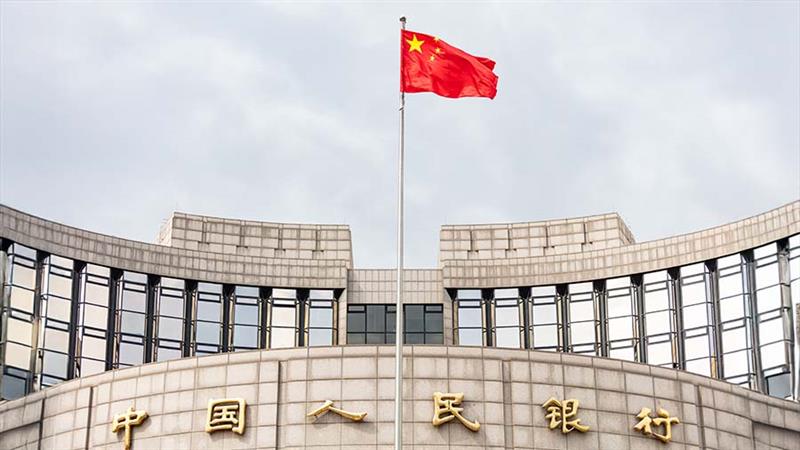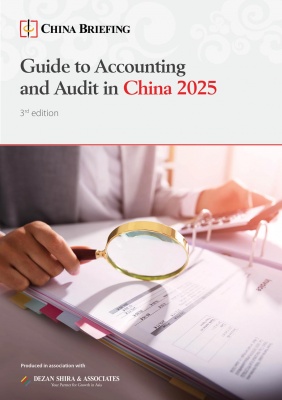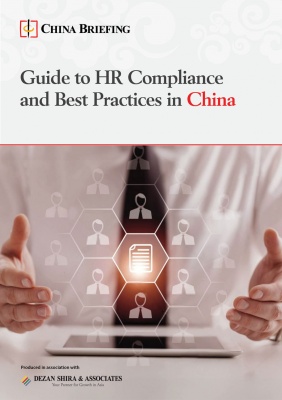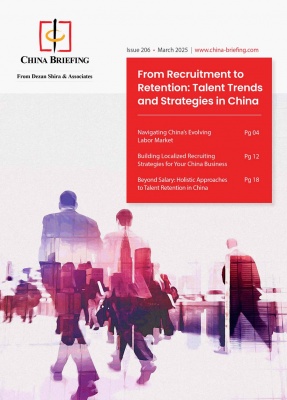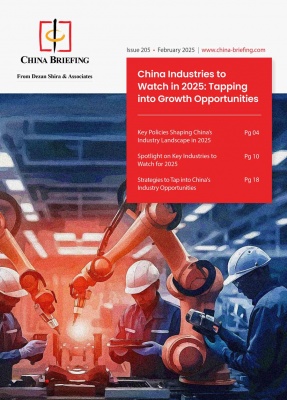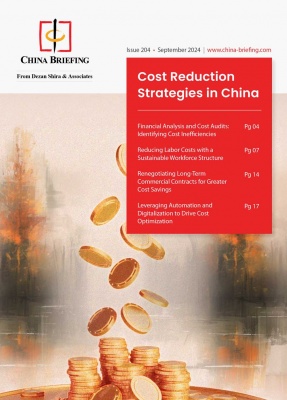China’s SaaS Market is Booming: Why Foreign Investors Should Pay Attention (Updated)
China’s software as a service (SaaS) market is one of the fastest-growing industries in the country. China Briefing examines key growth drivers and challenges faced by market players, and discusses prospects for foreign investment.
The Chinese software as a service (SaaS) industry is starting to boom. The market has almost doubled in just over two years from 2018 to 2020, to an output value of RMB 49.82 billion (US$7 billion).
In this article, we analyze the prospects for foreign companies thinking of entering the Chinese SaaS market.
Software as a service
SaaS is a software delivery model whereby software is provided on a subscription basis over the internet rather than installed directly on the customer’s own hardware.
The advantages are that no additional software or hardware needs to be installed, the setup is much quicker, and software updates are usually included in the subscription.
The disadvantages are that customers have less control over software customization, sensitive data can often be accessed by the provider, and the software requires internet connection for use.
SaaS market size and segmentation in China
The Chinese SaaS market is still relatively small, indicating that there is significant room for foreign firms to be strong competitors in both developed and underdeveloped product segments.
China’s SaaS market’s growth rate soared in 2018, decreased somewhat in 2019, and grew again in 2020 because of the COVID-19 pandemic. The market reached a peak of RMB 53.8 billion (US$7.56 billion) in the first quarter of 2021, up 48.7 percent from 2019. The capital market’s stance toward SaaS is stabilizing and the product market is maturing. The Chinese SaaS market’s CAGR is estimated to reach approximately 34 percent by 2024.
Currently, business management, data analysis services, office communication tools, and information security services are the most demanded products in China’s SaaS market. In comparison to the market size of each segment in 2019, information security services, data analysis services, office communication tools, and operation management businesses have all grown at a pretty rapid pace.
Other business segments are still in the very early stages of expansion but are expected to grow as the SaaS market develops.
Looking at regional differences, in 2020 the SaaS market size in eastern China reached RMB 40.02 billion (US$5.62 billion), accounting for 80 percent of the total output, followed by RMB 6.1 billion in the western region, RMB 2.27 billion (US$319 million) in the central region, and RMB 1.42 billion (US$196 million) in the northeastern region. In terms of market size, the top three provinces are Beijing, Guangdong, and Shanghai, followed by Shandong, Zhejiang, Henan, Jiangsu, Sichuan, Hebei, and Liaoning.
Historic and projected market growth
In comparison to the worldwide SaaS market, China had early-stage experimental development from 2004 to 2005 and later around 2010.
From 2013 to 2015, the Chinese SaaS market grew at around 65 percent to 75 percent per annum before leveling out in 2016. After 2016, with rising “cloud” awareness and enterprise acceptance of SaaS, China’s SaaS sector kicked off a new wave of expansion, with the local SaaS market entering the fast lane.
From 2018, the sector experienced a growth rate of 35 percent to 45 percent year-on-year until 2020, when the SaaS market size exceeded expectations, growing to about RMB 50 billion (over US$7 billion), highlighting expansion prospects for foreign companies.
Market fragmentation: An opportunity for foreign entrants
The domestic SaaS market is fragmented, with dominant firms in each horizontal SaaS link (such as procurement, HRM, CRM, OA, and video conferencing) and each vertical SaaS sector (such as e-commerce, catering, logistics, and education). Overall, vendors in the lowest layer of the sector are now exploring market segment needs, vendors in the middle layer are seeking increasing space, and vendors in the top layer are devoted to breaching the growth ceiling.
The top players are Kingdee (with a market share of 6.8 percent), Kingsoft cloud, China Youzan, and Weimob. The top 10 companies in terms of market share control only 35.6 percent of the market.
No big market leaders have emerged yet, nor have local firms expanded out of China. This is mainly because the domestic market is still developing, and firms are benefiting from domestic growth. Indeed, the adoption of SaaS by Chinese SMEs, which accounted for 60 percent of China’s output GDP as of 2022, is problematic since investing in the software of any type is not a learned reward loop, and automating or documenting using software is not a common practice. In addition, Chinese SMEs often do not have the cash reserves to invest in upgrading in a methodical manner.
Such a lack of consolidation means that even small foreign entrants with a quality product and an effective strategy will be able to compete in the Chinese SaaS market.
What’s driving growth in China’s SaaS market
Shift to cloud infrastructure
China is beginning to shift away from commodity hardware to cloud-based infrastructure.
From 2017 to 2019, the growth rate of commodity hardware fell by five percent and was replaced by growth in cloud-based services revenue. As a result, China’s public cloud is predicted to more than double in size in the next few years, growing from US$32 billion in 2021 to an estimated US$90 billion by 2025.
In 2022, combined cloud and non-cloud enterprise resource planning (ERP) software revenue is projected to reach US$1.89 billion.
SME growth
Large companies and state-owned enterprises (SOEs) have been slower to take up SaaS software because they have often made pre-existing capital investment in traditional enterprise software and hardware.
There are also concerns regarding data security because sensitive data is often stored on cloud infrastructure and are accessible by the SaaS provider.
Small and medium enterprises (SMEs), however, have tighter capital budgets. This means they are more attracted to the SaaS subscription model.
Around 97 percent of all companies in China are SMEs, and they account for about 90 percent of the country’s private sector. From 2012 to 2019, new registrations of private companies increased by an average of 20.2 percent every year, and there were about 20 million private-controlled firms registered in China by the end 2019. All in all, the share of the private sector in China has been steadily growing, from zero in the mid-2000s to 19 percent of the total (US$1.7 trillion out of US$8.8 trillion) in 2021.
The continued growth of private SMEs will continue to deepen the market for SaaS products considerably.
The major challenge for the industry, however, is to build interest in enterprise software among SMEs, as less experienced SMEs often do not understand the benefits that the software provides.
Wage growth
As wages continue to rise and the cost of labor becomes more expensive, simply hiring more labor will no longer be as sensible to solve business problems. Going forward, firms will increasingly have to focus on labor productivity to save costs.
The average private sector wage in China has seen consistent growth.
From 2010 to 2021, private sector wages have been increasing at an average of 12 percent. Sitting at 8.9 percent growth in 2021, average private sector wages grew to about RMB 62,884 (US$8,837), an increase of RMB 5,157 (US$724) over the previous year. And in the IT sector, the growth rate reached 13.2 percent year-on-year.
As private sector wages continue to grow, SMEs will begin to rely more heavily on productivity, driving growth for SaaS solutions that streamline business processes.
How to enter the Chinese market: Key legal requirements
Model for selling SaaS services in China
There is only one legal method of entering the Chinese SaaS market as a foreign company. This model, used by both Microsoft and Apple to sell SaaS services in China, is laid out below:
- The SaaS software must be located on a server in China. If the server is located outside China, it is illegal to provide SaaS services.
- Despite regulation indicating that joint ventures can provide SaaS services, the provider must be a fully-owned Chinese entity.
- Foreign firms cannot be issued internet content provider (ICP) licenses. As such, the Chinese entity providing the service must obtain one itself.
The only other option is to operate the server outside China. This makes the connection speed much slower and is not recommended due to its illegality. Furthermore, the URL can easily be blocked by the government, so any company seriously wanting to enter the market should not pursue this path.
Find a Chinese provider
The central complication arising from the legal requirements is finding a Chinese provider that is willing to obtain an ICP license. Obtaining ICP licenses are very expensive and the Chinese licensee must pay all the costs.
As such, the provider must have the technical capability to operate the server as well as the financial resources to obtain the license.
Intellectual property and security
For more established SaaS providers, another problem is that the Chinese provider might actually be a competitor.
This brings with it intellectual property concerns given the Chinese provider will have access to all the data and software on the server. Furthermore, the data on any server located in China can be accessed by the Chinese government. Personal data, “sensitive” data, and cross-border data flows are all covered under data security, which is a similar yet distinct problem from telecom operations licensing in China. In 2021, it became clearer how China officials define various sorts of data and whether that data must remain within China or can be shared across borders. The passing of China’s Data Security Law also symbolizes a positive step forward from prior draft laws, which initially took a more stringent approach to cross-border data transfers.
Selling SaaS services is nevertheless often safer than traditional software delivery methods because customers do not have direct access to the software’s code.
Foreign players enjoy market share despite local competition
In general, Chinese business practices make it difficult for foreign firms to be successful if they do not understand them. Because partnering with a Chinese firm is necessary for entering the Chinese SaaS market, firms need to be accustomed with practices such as the concept of managing mianzi (face) in the process of relationship building.
Domestic firms also often have a greater understanding of the Chinese marketplace, allowing them to tailor their products to suit the target market. Among many factors, foreign firms need to consider:
- Tailoring software to fit Chinese accounting and finance requirements;
- Providing regular software updates to keep up with the fast-changing regulatory environment; and
- Conducting proper translations into Chinese.
Domestic firms also have exclusive access to the lucrative SOE market because of the government’s domestic procurement policy for technology products. Nevertheless, as much of the growth is expected to come from the SME market, this should not be a huge concern.
Despite these difficulties, of the top 10 companies in terms of market share, in 2021 some core players still include foreign firms such as Shopify, SAS Institute, Brightpearl, Revel Systems, and Lightspeed. This shows that by working with experts to create the right strategy and tailoring the product to local needs, it is very possible for a foreign firm to succeed in China in the SaaS market.
This article was first published on April 11, 2019, and last updated on October 4, 2022.
About Us
China Briefing is written and produced by Dezan Shira & Associates. The practice assists foreign investors into China and has done so since 1992 through offices in Beijing, Tianjin, Dalian, Qingdao, Shanghai, Hangzhou, Ningbo, Suzhou, Guangzhou, Dongguan, Zhongshan, Shenzhen, and Hong Kong. Please contact the firm for assistance in China at china@dezshira.com.
Dezan Shira & Associates has offices in Vietnam, Indonesia, Singapore, United States, Germany, Italy, India, and Russia, in addition to our trade research facilities along the Belt & Road Initiative. We also have partner firms assisting foreign investors in The Philippines, Malaysia, Thailand, Bangladesh.
- Previous Article Interest Rate Hikes in the US and Eurozone, RMB Depreciation, and the Implications
- Next Article China Releases First Guidelines for Cross-Border Data Transfer Application

